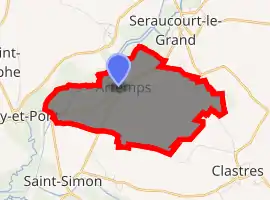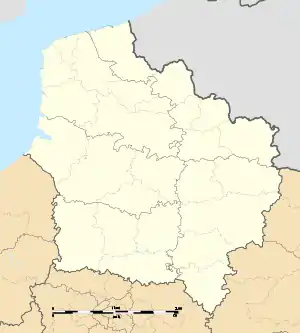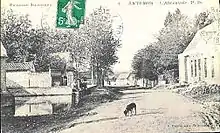Artemps
Artemps is a commune in the department of Aisne in the Hauts-de-France region of northern France.
Artemps | |
|---|---|
.JPG.webp) The Rue du canal | |
Location of Artemps 
| |
 Artemps  Artemps | |
| Coordinates: 49°45′57″N 3°11′26″E | |
| Country | France |
| Region | Hauts-de-France |
| Department | Aisne |
| Arrondissement | Saint-Quentin |
| Canton | Ribemont |
| Intercommunality | Saint-Quentinois |
| Government | |
| • Mayor (2014-2020) | Jean-Claude Dusanter |
| Area 1 | 6.31 km2 (2.44 sq mi) |
| Population (2017-01-01)[1] | 371 |
| • Density | 59/km2 (150/sq mi) |
| Time zone | UTC+01:00 (CET) |
| • Summer (DST) | UTC+02:00 (CEST) |
| INSEE/Postal code | 02025 /02480 |
| Elevation | 62–93 m (203–305 ft) (avg. 77 m or 253 ft) |
| 1 French Land Register data, which excludes lakes, ponds, glaciers > 1 km2 (0.386 sq mi or 247 acres) and river estuaries. | |
The inhabitants of the commune are known as Artempois or Artempoises[2]
Geography
Artemps is located 10 km south-west of Saint-Quentin and 7 km north-east of Ham. It can be accessed by the D32 road from Saint-Simon in the south passing through the heart of the commune and the village and continuing to Seraucourt-le-Grand in the north. There are a few country roads in the commune and the old Saint-Simon – Clastres Air Base is in the south-east of the commune. The commune is mostly farmland with a forest belt along the whole northern border.[3]
The Somme river flows along the northern border forming part of the border and the Canal of Saint-Quentin passes through parallel to the river inside the commune.[3]
Neighbouring communes and villages
Administration
List of Successive Mayors of Artemps[4]
| From | To | Name | Party | Position |
|---|---|---|---|---|
| 2001 | Present | Jean-Claude Dusanter | DVD |
(Not all data is known)
Population
| Year | Pop. | ±% |
|---|---|---|
| 2006 | 354 | — |
| 2007 | 356 | +0.6% |
| 2008 | 359 | +0.8% |
| 2009 | 364 | +1.4% |
| 2010 | 359 | −1.4% |
| 2011 | 360 | +0.3% |
| 2012 | 360 | +0.0% |
| 2013 | 362 | +0.6% |
| 2014 | 366 | +1.1% |
| 2015 | 368 | +0.5% |
| 2016 | 369 | +0.3% |

Sites and Monuments

- St. Martin's Church
This church is one of the few in France to have a steeple topped by two cocks. The church has undergone many changes over the years but was not completely destroyed during the two world wars. Most windows have been preserved and on one of them the master glassmaker represented the church.
 Statue of Saint Pierre in the church
Statue of Saint Pierre in the church Stained glass window in the church
Stained glass window in the church The steeple with its two cocks
The steeple with its two cocks
See also
External links
- Artemps on the old IGN website (in French)
- Bell Towers website (in French)
- Artemps on Lion1906
- Artemps on Géoportail, National Geographic Institute (IGN) website (in French)
- Arthem on the 1750 Cassini Map
Notes and references
Notes
References
- "Populations légales 2017". INSEE. Retrieved 6 January 2020.
- Inhabitants of Aisne (in French)
- Google Maps
- List of Mayors of France (in French)
| Wikimedia Commons has media related to Artemps. |